📞+86 153 7530 2641 📧 hongjing.Wang@feichuncables.com
How Long Do Different Cable Insulation Materials Last—and How Can You Extend Their Lifespan?
Discover the lifespan of different cable insulation materials such as PVC, XLPE, EPR, and Teflon. This guide explains how temperature, voltage, and environmental conditions affect durability—and how to extend cable life in demanding applications like port and industrial systems.
hongjing.Wang@Feichun
7/21/202511 min read
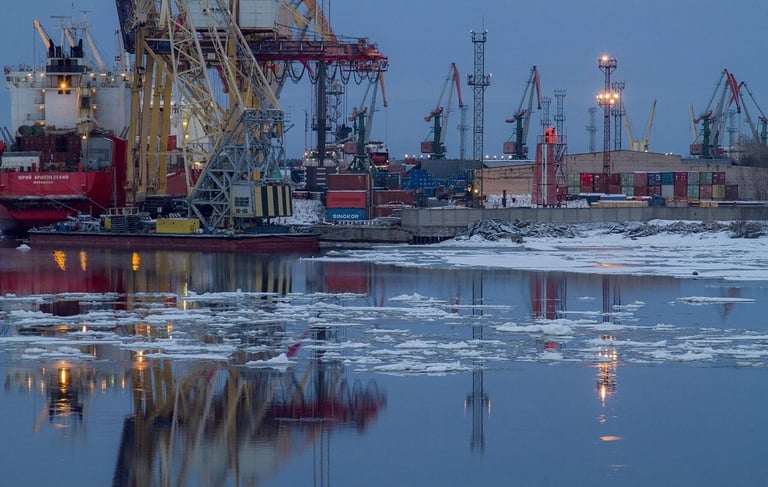

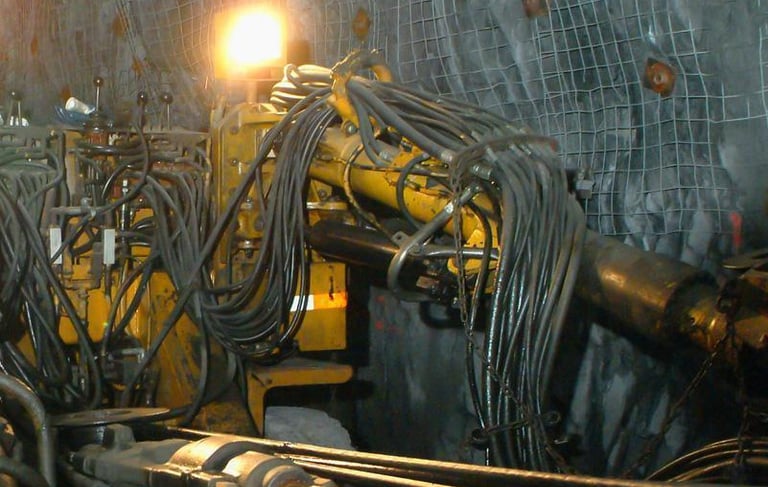

Introduction
In industrial facilities, port operations, and harsh environmental conditions, electrical cables serve as the vital arteries that keep critical systems operational. Understanding cable lifespan becomes paramount when considering the significant costs associated with unplanned downtime, emergency replacements, and potential safety hazards. Whether powering massive port cranes, connecting ship-to-shore systems, or maintaining continuous operations in chemical processing plants, the longevity and reliability of electrical cables directly impact operational efficiency and safety standards.
Cable aging and failure stem from multiple interconnected factors that work together to degrade insulation integrity and conductor performance over time. Temperature fluctuations, electrical stress from varying loads, environmental exposure to UV radiation and corrosive chemicals, and mechanical stresses from constant flexing all contribute to the gradual deterioration of cable systems. The challenge lies in predicting when these factors will combine to cause failure and implementing strategies to maximize cable life expectancy while maintaining safe operating conditions.
This comprehensive guide will equip you with the knowledge to understand cable lifespan fundamentals, identify key degradation factors, apply scientific estimation methods, and implement proven strategies to extend cable life. You'll learn practical approaches for selecting appropriate materials for specific applications, calculating thermal aging effects, and developing maintenance protocols that protect your investment in cable infrastructure.
1. Understanding Cable Lifespan: What Does It Depend On?
Cable lifespan encompasses both mechanical durability and electrical performance capability throughout the service life of the installation. This dual nature means that cables must maintain their structural integrity while continuing to provide reliable electrical conductivity and insulation properties under specified operating conditions. The electrical cable life expectancy represents the period during which the cable can safely carry its rated current and voltage without experiencing insulation breakdown or conductor degradation that could lead to system failure.
Different insulation materials exhibit varying longevity characteristics based on their molecular structure and resistance to environmental stresses. Polyvinyl Chloride (PVC) insulation typically provides 20-30 years of service life under normal operating conditions, making it suitable for general-purpose applications where cost considerations are primary. Cross-linked Polyethylene (XLPE) insulation extends this range to 30-40 years, offering superior thermal performance and chemical resistance that justifies its use in more demanding applications.
Ethylene Propylene Rubber (EPR) insulation falls between these materials with a 25-35 year lifespan, providing excellent flexibility and thermal properties that make it ideal for applications requiring frequent movement or temperature variations. At the premium end, Teflon (PTFE) insulation can achieve 40-50 years of service life, delivering exceptional chemical resistance and high-temperature capability that supports critical applications in aerospace, chemical processing, and other specialized industries.
The determination of cable lifespan depends on the weakest link principle, where the component with the shortest expected life determines the overall system longevity. In most cases, the insulation material serves as this limiting factor, though conductor corrosion, jacket degradation, or mechanical failure can sometimes determine the replacement timeline.
2. Key Factors Affecting Cable Lifespan
2.1 Insulation Material Type
The selection of insulation material fundamentally determines cable performance characteristics and expected service life. Each material type offers distinct advantages and limitations that must be matched to specific application requirements and environmental conditions.
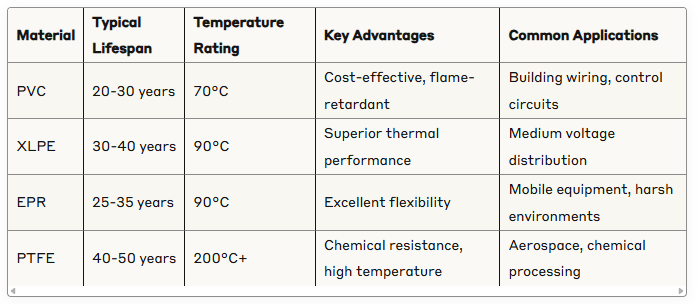

PVC insulation dominates cost-sensitive applications where moderate performance requirements make it the practical choice for building installations and low-stress environments. However, its temperature limitations and susceptibility to certain chemicals restrict its use in demanding industrial applications. XLPE insulation provides enhanced thermal capability and moisture resistance, making it the preferred choice for underground distribution systems and medium-voltage applications where long-term reliability justifies the additional cost.
EPR insulation excels in applications requiring mechanical flexibility and thermal cycling resistance, such as portable equipment, crane cables, and reeling applications. Its rubber-based formulation maintains flexibility at low temperatures while providing good thermal aging characteristics. PTFE insulation, despite its premium cost, becomes essential in applications involving extreme temperatures, aggressive chemicals, or critical reliability requirements where failure consequences justify the investment.
2.2 Operating Temperature and Thermal Stress
Operating temperature represents the most critical factor influencing cable lifespan, with insulation degradation following exponential relationships that dramatically reduce service life at elevated temperatures. The Arrhenius Equation provides the scientific foundation for understanding thermal aging effects:
L = L₀ × e^(E / kT)
Where:
L = Estimated lifespan (hours)
L₀ = Reference lifespan at standard conditions
E = Activation energy (eV)
k = Boltzmann constant (8.6173 × 10⁻⁵ eV/K)
T = Absolute temperature (Kelvin)
This relationship demonstrates that every 10°C increase in operating temperature typically reduces cable lifespan by approximately 50%, emphasizing the importance of thermal management in cable system design. The exponential nature of this degradation means that small temperature increases can have dramatic effects on long-term reliability.
Internal heat generation from conductor losses compounds external temperature effects, creating thermal stress that accelerates insulation aging. High-current applications must account for I²R losses that elevate conductor temperature above ambient conditions, requiring careful consideration of current-carrying capacity derating and thermal dissipation design.
2.3 Electrical Load: Voltage and Current
Electrical stress from voltage and current loading creates additional degradation mechanisms that interact with thermal effects to reduce cable lifespan. Overvoltage conditions generate electrical fields within insulation materials that can initiate partial discharge activity, leading to gradual insulation deterioration and eventual breakdown.
Overcurrent conditions produce excessive heat that accelerates thermal aging while potentially causing immediate damage to conductor connections and insulation integrity. Proper load management requires understanding derating factors that account for installation conditions, ambient temperature, and grouping effects that influence heat dissipation capability.
Current harmonics from variable frequency drives and other electronic loads create additional heating effects that must be considered in thermal calculations. These high-frequency components can cause skin effect losses that concentrate heating in conductor surfaces, while also generating electromagnetic interference that may affect nearby sensitive circuits.
2.4 Environmental Impacts
Environmental factors create multiple stress mechanisms that work synergistically to degrade cable materials and reduce service life. Ultraviolet radiation from sunlight breaks down polymer chains in cable jackets and insulation, causing embrittlement and cracking that allows moisture ingress and reduces mechanical protection.
Chemical exposure from industrial processes, cleaning agents, and atmospheric pollutants can attack cable materials through various mechanisms including oxidation, hydrolysis, and direct chemical reaction. Acidic and alkaline environments are particularly aggressive, requiring careful material selection and protective measures to achieve acceptable service life.
Water ingress represents one of the most common failure mechanisms in outdoor cable installations. Moisture penetration leads to conductor corrosion, insulation swelling, and reduced dielectric strength that can cause immediate failure or accelerate long-term degradation. Salt water exposure in marine environments amplifies these effects through enhanced conductivity and corrosive action.
Mechanical stress from vibration, flexing, and physical impact creates fatigue effects that gradually damage conductor strands and insulation integrity. Port crane applications exemplify these challenges, where cables experience continuous flexing, tension variations, and exposure to harsh environmental conditions that demand robust design and premium materials.
3. Lifespan Estimation Methods
Accurate lifespan estimation requires application of thermal aging principles combined with understanding of specific operating conditions and material characteristics. The thermal aging formula provides a quantitative foundation for these calculations:
L = L₀ × e^(E / kT)
For practical application, consider an XLPE cable operating at 70°C with an activation energy of 0.7 eV:
Operating temperature: 70°C = 343 K
Activation energy: E = 0.7 eV
Boltzmann constant: k = 8.6173 × 10⁻⁵ eV/K
L = L₀ × e^(0.7 / (8.6173 × 10⁻⁵ × 343)) L = L₀ × e^(23.65) L = L₀ × 1.85 × 10¹⁰
This calculation demonstrates the exponential relationship between temperature and lifespan, though practical application requires calibration against actual service data and consideration of other degradation factors beyond thermal aging alone.
The limitations of thermal aging calculations include assumptions of constant temperature operation, uniform material properties, and single-mechanism degradation that may not reflect real-world conditions. Environmental factors, mechanical stress, and electrical loading create additional degradation pathways that require separate analysis and combination through appropriate statistical methods.
4. Cable Lifespan by Temperature – Practical Table
Understanding the relationship between operating temperature and cable lifespan enables informed decisions about system design, material selection, and operating parameter limits. The following table provides practical guidance for three common insulation materials:

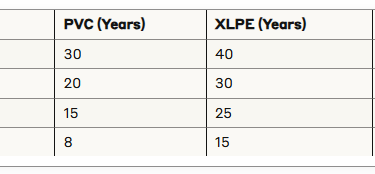
These values demonstrate the dramatic impact of temperature on cable life expectancy, with all materials showing approximately 50% reduction in lifespan for each 20°C temperature increase. This trend emphasizes the critical importance of thermal management in cable system design and operation.
At moderate temperatures (50°C), all three materials provide acceptable service life for most applications, with XLPE offering the longest expectancy. However, as temperatures increase toward maximum ratings, the differences become more pronounced, with PVC showing rapid degradation while XLPE maintains relatively better performance.
The exponential nature of thermal degradation means that operating cables below their maximum temperature rating provides disproportionate benefits in terms of extended service life. Derating current capacity by 10-20% to reduce operating temperature can potentially double the expected cable lifespan.
5. Strategies to Extend Cable Lifespan
Temperature Control in High-Current Environments
Effective thermal management represents the most impactful strategy to extend cable lifespan, requiring careful attention to heat generation, dissipation, and environmental factors. Proper cable sizing ensures that conductor losses remain within acceptable limits, while installation methods that promote heat dissipation prevent temperature accumulation that accelerates aging.
Underground installations benefit from soil thermal properties that provide heat sinking, though soil thermal resistivity must be considered in ampacity calculations. Above-ground installations require adequate ventilation and spacing to prevent heat buildup, particularly in cable tray installations where grouping effects reduce individual cable ampacity.
Active cooling systems may be justified in high-value applications where premium cable costs make thermal management economically attractive. These systems can include forced air ventilation, liquid cooling, or thermal barriers that reduce ambient temperature exposure.
Proper Load Management
Avoiding overvoltage and overcurrent conditions requires comprehensive understanding of system operating characteristics and appropriate protection system design. Voltage regulation equipment maintains stable voltage levels that prevent electrical stress from voltage fluctuations, while current monitoring systems provide early warning of overload conditions.
Harmonic mitigation through proper filter design reduces heating from non-sinusoidal currents that are increasingly common in modern electrical systems. Power quality analysis identifies these issues and guides corrective measures that protect cable investments.
Load diversity calculations allow optimization of cable sizing by accounting for actual operating patterns rather than worst-case simultaneous loading that may rarely occur in practice.
Environmental Protection
UV-resistant cable materials or protective coverings prevent degradation from solar radiation exposure in outdoor installations. Specialized compounds that include UV stabilizers maintain material properties despite prolonged sunlight exposure, while physical barriers such as conduit or cable trays provide additional protection.
Waterproof cable designs incorporate moisture barriers, sealed connectors, and drainage provisions that prevent water ingress in wet environments. These features become critical in marine applications where salt water exposure creates particularly aggressive conditions.
Chemical resistance requirements must be matched to specific environmental exposures through careful material selection and protective measures. Some applications may require specialized jacket materials or protective conduits that isolate cables from aggressive chemicals.
Mechanical Protection
Reinforced jacketing provides protection against physical damage from impact, abrasion, and crushing forces that can occur during installation or operation. Steel wire armor or similar reinforcement may be required in applications where mechanical stress is severe.
Proper cable support and strain relief prevent mechanical fatigue from repetitive movement or vibration. This consideration is particularly important in mobile applications such as crane cables where continuous flexing occurs throughout the service life.
Routine Inspection and Preventative Maintenance
Systematic inspection protocols identify early signs of cable degradation before failure occurs, allowing planned replacement rather than emergency repairs. Visual inspection can detect jacket damage, connector corrosion, or physical displacement that indicates developing problems.
Electrical testing including insulation resistance measurement, partial discharge detection, and thermal imaging provides quantitative assessment of cable condition and aging trends. These techniques enable condition-based maintenance decisions that optimize cable replacement timing.
Documentation of inspection results and maintenance actions creates historical records that improve future decision-making and help identify systematic issues that may affect multiple installations.
6. Cable Lifespan in Port and Marine Applications
Port and marine environments present unique challenges that significantly impact cable lifespan through combinations of mechanical, electrical, and environmental stresses that exceed typical industrial applications. Ship-to-shore power systems, container crane operations, and marine vessel installations require specialized cable designs that address these demanding conditions.
Constant flexing from crane operations creates mechanical fatigue that gradually damages conductor strands and insulation materials. Reeling cable applications experience millions of flex cycles throughout their service life, requiring specialized construction with fine-stranded conductors and flexible insulation materials specifically designed for dynamic applications.
Saltwater corrosion affects both metallic components and organic materials through electrochemical processes that accelerate normal aging mechanisms. Copper conductors develop corrosion products that increase resistance and generate additional heat, while aluminum components require special attention to prevent galvanic corrosion at connection points.
High current requirements for large port cranes and ship propulsion systems generate significant internal heating that must be managed through appropriate cable sizing and thermal design. These applications often operate near maximum ampacity ratings, making thermal management critical for achieving acceptable service life.
Environmental protection becomes paramount in marine applications where cables face exposure to salt spray, temperature cycling, UV radiation, and mechanical abuse. Specialized jacket materials, sealed construction, and corrosion-resistant hardware are essential for reliable operation in these harsh conditions.
Cable selection for port and marine applications should prioritize EPR or XLPE insulation materials that provide superior flexibility and environmental resistance compared to PVC alternatives. Tinned copper conductors offer enhanced corrosion resistance, while specialized jacket compounds resist oil, ozone, and salt water exposure.
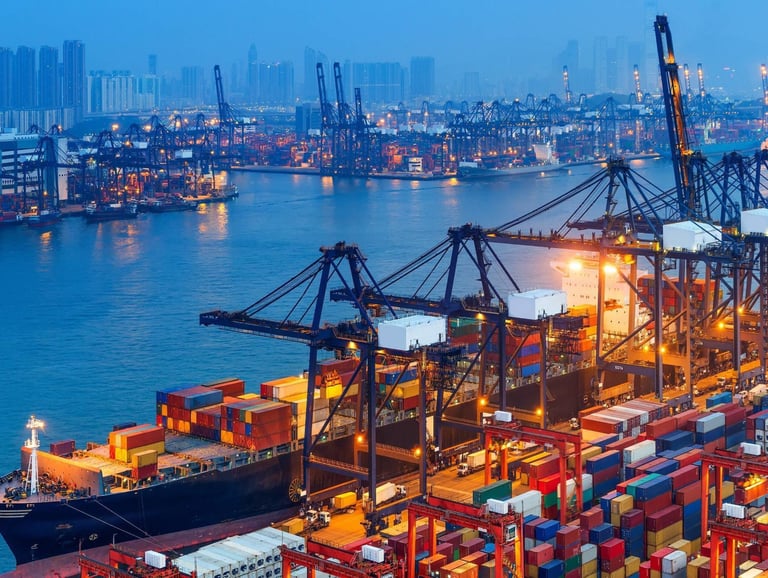

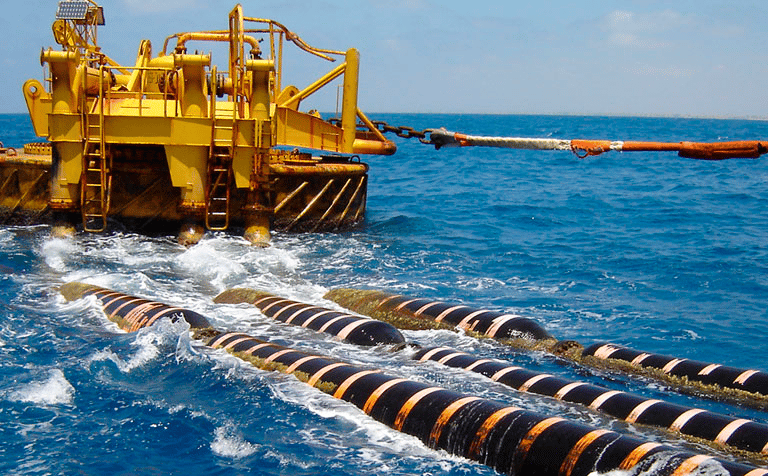

7. Frequently Asked Questions
What is the typical lifespan of XLPE insulated cables?
XLPE insulated cables typically provide 30-40 years of service life under normal operating conditions, with actual longevity depending on operating temperature, electrical loading, and environmental factors. At moderate temperatures (50°C), XLPE cables can achieve the full 40-year expectancy, while operation at higher temperatures reduces this significantly. Proper installation and maintenance can help achieve the expected service life.
How do high temperatures affect cable life expectancy?
High temperatures dramatically reduce cable life expectancy through accelerated thermal aging of insulation materials. The relationship follows the Arrhenius equation, where each 10°C temperature increase typically reduces cable lifespan by approximately 50%. This exponential relationship means that temperature control provides the greatest impact on extending cable service life.
Can cables be used beyond their rated service life?
Cables may potentially operate beyond their design service life with appropriate testing and monitoring, though this practice requires careful risk assessment. Condition assessment through insulation resistance testing, partial discharge measurement, and thermal imaging can help evaluate remaining service capability. However, extended operation beyond design life increases failure risk and may not be appropriate for critical applications.
What are signs of cable insulation aging?
Signs of cable insulation aging include visible cracking or discoloration of jacket materials, reduced insulation resistance measurements, increased partial discharge activity, and elevated operating temperatures. Physical inspection may reveal embrittlement, ozone cracking, or moisture ingress that indicates deteriorating condition requiring attention.
How to protect outdoor cables from UV and moisture?
UV protection requires either UV-resistant cable materials containing stabilizing compounds or physical barriers such as conduit, cable trays with covers, or direct burial installation. Moisture protection involves proper sealing of connections, selection of waterproof cable constructions, adequate drainage provisions, and regular inspection of protective systems to ensure continued effectiveness.
8. Conclusion
Understanding cable lifespan involves complex interactions between material properties, operating conditions, and environmental factors that determine long-term reliability and performance. The exponential relationship between temperature and insulation aging makes thermal management the most critical factor in extending service life, while proper material selection ensures compatibility with specific application requirements.
Successful cable system design requires balancing initial costs against long-term performance expectations, considering factors such as replacement difficulty, downtime costs, and safety implications of premature failure. Proactive monitoring through systematic inspection and testing programs enables condition-based maintenance decisions that optimize replacement timing and prevent unexpected failures.
Environmental protection through appropriate material selection and physical barriers provides essential defense against degradation mechanisms that can dramatically reduce cable lifespan in harsh service conditions. Marine and industrial applications particularly benefit from specialized cable constructions that address specific environmental challenges.
The investment in premium cable materials and proper installation practices typically provides excellent returns through extended service life, reduced maintenance costs, and improved system reliability. Regular assessment of cable condition enables informed decisions about continued operation or replacement timing that balance risk against economic considerations.
Implementation of comprehensive cable management programs including proper design, installation, monitoring, and maintenance ensures maximum return on cable system investments while maintaining safe and reliable electrical power distribution throughout the intended service life.
How to Reach Us
Get in Touch
SiteMap
Product Catalogue
Reeling Cable
Festoon Cable
Shore Power Cable




Scan to add us on WeChat
